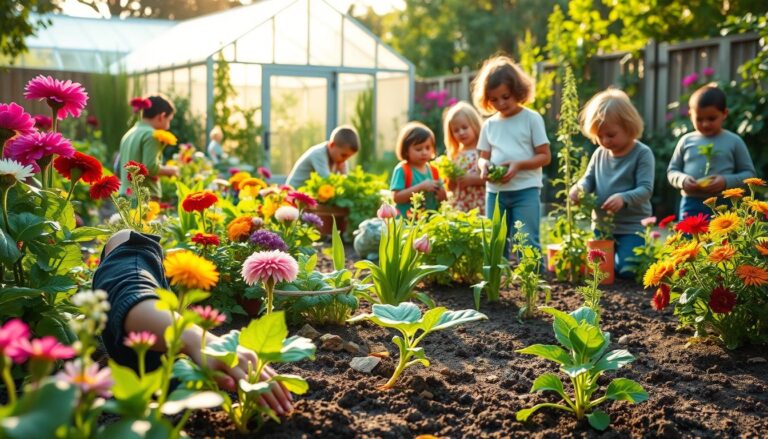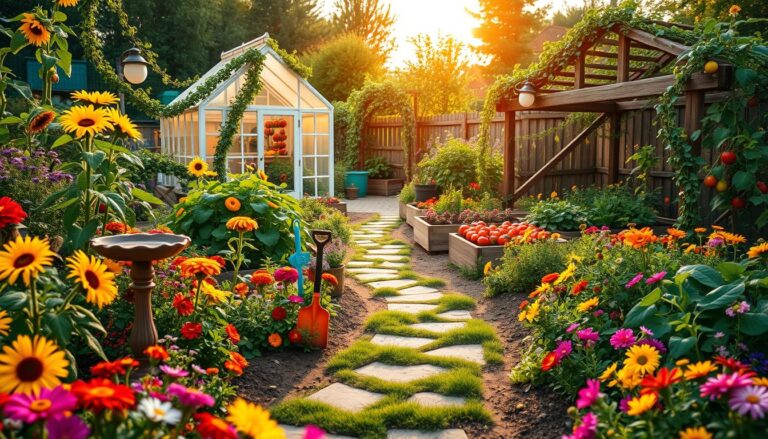Bringing the outdoors into your home can change your living space for the better. It not only cleans the air and makes your home look better. It also lets you grow your own herbs and plants all year.
With the right indoor gardening ideas, you can make any room a green oasis.
Whether you’re an expert or a beginner, our top tips will help you start. We’ll talk about picking the right plants and the best lighting. You’ll learn everything you need to know to create a thriving indoor garden.
By the end of this article, you’ll know how to make your home a greener, fresher place.
The Benefits of Indoor Gardening
Indoor gardening is more than just a pretty addition to your home. It offers many benefits for your health and well-being. Adding plants to your indoor space can greatly improve your life quality.
Physical and Mental Health Advantages
Indoor gardening is good for both your body and mind. Caring for plants can be calming, reducing stress and anxiety. Studies show that plants can lower blood pressure, boost mood, and help with depression symptoms.
Moreover, indoor plant care can be a rewarding hobby. It gives you a sense of accomplishment and improves your overall well-being.
The mental health advantages of indoor gardening are significant. The calming effect of plants can help with mental health issues. It makes your living space more peaceful and serene.
Environmental Impact and Air Purification
Indoor plants are not just pretty; they also clean the air. They absorb carbon dioxide and release oxygen, making your space healthier. Some plants are especially good at removing pollutants from the air, improving indoor air quality.
Indoor gardening also supports a greener lifestyle. Growing your own herbs or veggies indoors can cut down on industrial agriculture. This can help lower your carbon footprint.
Getting Started with Indoor Gardening for Beginners
Indoor gardening is a fun hobby that offers many benefits. It’s easy to begin. Knowing the basics is key to a successful indoor garden.
Essential Indoor Gardening Supplies
To start your indoor gardening journey, you’ll need some basic supplies. These include:
- Containers: Choose pots that fit your space and the mature size of your plants.
- Potting Mix: A well-draining mix is crucial to prevent waterlogged soil.
- Plants: Select varieties that are suitable for indoor conditions and your level of care.
- Watering Can or System: Consistent watering is key to healthy plants.
- Fertilizer: Provide your plants with necessary nutrients for growth.
Investing in these essential supplies will lay the foundation for a successful indoor garden. It’s also worth considering the quality and sustainability of the products you choose.
Creating a Successful Indoor Garden Plan
A well-thought-out plan is crucial for a thriving indoor garden. Here are some steps to consider:
- Assess Your Space: Evaluate the light, temperature, and humidity levels in your home.
- Choose the Right Plants: Select plants that match your indoor conditions and care capabilities.
- Plan for Maintenance: Regular watering, fertilizing, and pruning are essential for plant health.
- Consider Scalability: Start small and expand your garden as you gain experience.
By following these steps and being mindful of your plants’ needs, you can create a flourishing indoor garden that enhances your living space.
Choosing the Right Plants for Your Indoor Space
Finding the right plants for your indoor garden is key. You need to think about your lifestyle and the space you have. Consider how much care each plant needs, the light it requires, and how it will look in your space.
Think about how much time you can spend on plant care. Some plants need a lot of attention, like watering and pruning often. If you’re new to indoor gardening, start with plants that are easy to care for.
Best Low-Maintenance Plants for Beginners
For beginners, low-maintenance plants are best. These plants are tough and don’t need much care. They’re great for people who are busy or new to gardening. Here are some good options:
- Snake Plant: It cleans the air and grows well in little light.
- ZZ Plant: It only needs to be watered sometimes and can handle different light levels.
- Pothos: It’s easy to grow and can thrive in many light conditions.
Perfect Plants for Low Light Conditions
Not all rooms get a lot of sunlight. But, there are low light plants that can brighten up even the darkest spots. Here are some great choices:
| Plant | Lighting Conditions | Watering Needs |
|---|---|---|
| Chinese Evergreen | Low to Medium Light | Moderate |
| Pothos | Low to Bright Light | Low |
| Peace Lily | Low to Medium Light | Moderate |
Statement Plants for Visual Impact
If you want to make your indoor garden stand out, choose statement plants. These plants are eye-catching and can add elegance to any room. Here are some examples:
- Fiddle Leaf Fig: Its large, violin-shaped leaves add sophistication.
- Dracaena: It has striking leaves and grows tall, making a statement.
Understanding Light Requirements for Indoor Plants
Knowing what light indoor plants need is key for their health. Different plants need different amounts of light, from very little to a lot. This depends on their type and where they come from.
“Plants are not just decorative elements; they are living organisms that react to their environment,” as noted by gardening experts. The right light can really help them grow and stay healthy.
Maximizing Natural Light Sources
The first step is to use as much natural light as possible. Placing plants near windows that get direct sunlight is great. But, remember, windows facing south get more sun than those facing north.
Using mirrors opposite windows can also help. They reflect natural light to areas that don’t get much.
Selecting the Right Artificial Lighting
If natural light isn’t enough, you’ll need artificial light. LED grow lights are a top pick because they save energy and help plants grow well.
Think about what kind of plants you have when choosing artificial light. Plants that need a lot of light, like those that bloom, need brighter lights. Plants that do well in low light, like Chinese Evergreen, need less intense light.
- LED grow lights for energy efficiency
- Fluorescent lights for a balanced spectrum
- Incandescent lights for warmth, though less efficient
Mastering Watering and Humidity for Indoor Plants
To have a lush indoor garden, you need to know how to water and keep humidity right. The health of your plants depends on these two things.
Proper Watering Techniques by Plant Type
Every plant is different when it comes to water. Succulents and cacti need less water than plants like ferns and peace lilies. Knowing what your plants need is key to keep them healthy.
Watering Techniques for Different Plant Types:
- Succulents and Cacti: Water sparingly, allowing soil to dry out completely between waterings.
- Tropical Plants: Keep the soil consistently moist but not waterlogged.
- Herbs: Water regularly, ensuring the soil remains moist but not soggy.
| Plant Type | Watering Frequency | Soil Moisture Level |
|---|---|---|
| Succulents/Cacti | Sparingly | Dry between waterings |
| Tropical Plants | Regularly | Consistently moist |
| Herbs | Regularly | Moist but not soggy |
Effective Methods to Increase Humidity
Indoor plants often face low humidity, especially in air-conditioned or heated rooms. There are ways to make the air around your plants more humid.
Methods to Increase Humidity:
- Using a Humidifier: Place a humidifier near your plants to maintain a humid microclimate.
- Grouping Plants: Cluster plants together to create a humid environment through transpiration.
- Pebble Tray: Place plants on a tray filled with water and pebbles, as the evaporating water increases humidity.
By learning how to water your plants right and using methods to boost humidity, you can make your indoor garden thrive. This will bring joy and freshness to your home.
Soil, Containers, and Fertilization Essentials
The success of your indoor garden depends on three key things: the right potting mix, the right containers, and a good fertilization schedule. Knowing and using these well can greatly improve your plants’ health and growth.
Choosing the right parts for your indoor garden is very important. It helps create the best place for your plants to grow. Let’s look at each part to make sure your plants do well.
Selecting the Right Potting Mix for Different Plants
The potting mix is the base of a healthy indoor garden. Different plants need different things. For example, orchids need a mix that drains well to avoid root rot. Succulents need a mix that holds less water.
Most houseplants do well in general-purpose potting mixes. But, plants like cacti and tropical plants might need special mixes.
Stylish and Functional Container Options
Containers do more than just hold soil and plants. They also add to your indoor garden’s look. Choose containers that are both stylish and practical. Make sure they have holes for drainage to avoid waterlogged soil.
Materials like terracotta, ceramic, and wood give a natural look. Plastic and metal containers offer a modern style. Pick a container size that fits your plant well, allowing for enough room for roots to grow.
Seasonal Fertilization Schedule and Types
A good fertilization schedule is key for your plants’ nutrition all year. Most houseplants need fertilizing in the growing season (spring and summer). Use a balanced, water-soluble fertilizer then.
In the dormant season (fall and winter), fertilize less often. Plants need fewer nutrients when they’re not growing. Organic fertilizers like compost tea or fish emulsion are great alternatives to synthetic ones. They offer a natural way to feed your plants.
Creative Indoor Gardening Ideas for Small Spaces
Small space gardening doesn’t have to be a challenge. You can still enjoy a lush indoor garden with the right strategies. For those in apartments or homes with little space, there are many ways to bring greenery into your life.
Vertical Gardening Solutions for Limited Floor Space
Vertical gardening is a great way to garden in small spaces. It uses walls or trellises to grow plants upwards, making the most of your space. Vertical gardens can be made from wooden pallets, metal grids, or modular systems.
Windowsill and Countertop Micro-Gardens
Creating micro-gardens on windowsills or countertops is another smart idea. These small gardens can be as simple as a few pots of herbs. They add greenery and fresh produce right in your kitchen.
- Use shallow containers for root vegetables or herbs.
- Select plants that thrive in indoor conditions, such as succulents or leafy greens.
- Ensure good air circulation to prevent fungal diseases.
Multi-Purpose Furniture with Built-In Planters
Using multi-purpose furniture with built-in planters is both stylish and practical. This includes coffee tables with planters, storage ottomans for plants, or shelving units that serve as plant stands.
| Gardening Idea | Space Requirement | Best For |
|---|---|---|
| Vertical Gardening | Low | Herbs, Leafy Greens |
| Micro-Gardens | Very Low | Herbs, Small Vegetables |
| Multi-Purpose Furniture | Variable | Variety of Plants |
With these creative indoor gardening ideas, even the smallest spaces can become vibrant gardens. Whether you’re an experienced gardener or just starting, there’s a solution for you. It will enhance your indoor environment.
Specialized Indoor Garden Projects
Looking beyond the basics, specialized indoor gardening projects can change your home and gardening skills. These projects meet different interests and needs, offering many options for indoor gardeners.
Creating a Thriving Indoor Herb Garden
An indoor herb garden lets you have fresh herbs all year. Start by picking herbs you like to cook with, like basil, mint, and rosemary. Make sure your herbs get enough light; most need 4-6 hours of direct sunlight daily.
If sunlight is scarce, use grow lights. Choose a potting mix that drains well and use containers that are 6-8 inches deep. Water and fertilize regularly. Pinch off flower buds to keep your herbs bushy and full of leaves.
Growing Vegetables and Microgreens Indoors
Growing vegetables indoors is rewarding, giving you fresh food at home. Leafy greens like lettuce, kale, and spinach grow well indoors. Microgreens, young versions of these greens, also thrive indoors.
You’ll need containers with good drainage, the right growing medium, and enough light. Most veggies need more light than herbs; LED grow lights can help. Keep the temperature and humidity steady for best growth.
Urban Indoor Gardening Techniques for Apartments
Urban indoor gardening in apartments needs creativity and smart space use. Vertical gardening is great, using wall planters or trellises to save space. Hanging baskets and window boxes also add greenery without using floor space.
| Technique | Description | Space Requirement |
|---|---|---|
| Vertical Gardening | Utilizes wall-mounted planters or trellises | Minimal floor space |
| Hanging Baskets | Hangs from ceiling or hooks | No floor space required |
| Window Boxes | Attached to windowsills | Utilizes window area |
Using these urban indoor gardening techniques, apartment dwellers can garden even with little space.
Conclusion: Transforming Your Living Space with Indoor Plants
Adding indoor plants to your home is a simple way to make it look better and feel better. It creates a calm and peaceful space. This can help you relax and feel less stressed.
Indoor gardening brings nature inside, making your air cleaner and your home more beautiful. This is true whether you’re new to gardening or have been doing it for years. The tips in this article will help you start your indoor gardening journey.
Choosing the right plants and knowing what they need is key. With creative ideas, you can turn your home into a green oasis that shows off your style. So, why not start today and see how indoor gardening can change your life?
FAQ
What are the best plants for indoor gardening beginners?
How often should I water my indoor plants?
Can I grow herbs indoors, and if so, which ones are easiest to grow?
What is the best way to increase humidity for my indoor plants?
How can I maximize natural light for my indoor plants?
What are some creative ways to garden indoors with limited space?
How do I choose the right potting mix for my indoor plants?
Can I use LED grow lights for my indoor garden?
How often should I fertilize my indoor plants?

Sortemdia nasceu com o propósito de trazer alegria e oportunidades para todos por meio de sorteios gratuitos de prêmios incríveis. O site tem como missão oferecer experiências acessíveis, divertidas e justas para quem deseja concorrer a produtos, serviços e brindes sem pagar nada por isso. Acreditamos que a sorte pode bater à porta de qualquer pessoa — e no Sortemdia, ela pode chegar com apenas um clique.



